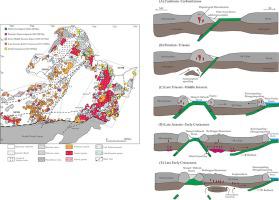Ore Geology Reviews ( IF 3.2 ) Pub Date : 2021-05-01 , DOI: 10.1016/j.oregeorev.2021.104204 Ruiliang Wang , Qingdong Zeng , Zhaochong Zhang , Lingli Zhou , Kezhang Qin

|
The eastern segment of the Xingmeng orogenic belt (EXOB) hosts numerous Mo, polymetallic Ag, Pb–Zn, Sn, Cu, Au (Ag), and rare-earth element (REE) deposits and is one of the most important polymetallic-ore regions globally. The mineralization type includes i) porphyry Cu (Mo, Au), Mo (Cu, Pb–Zn, W), Sn (Cu–Ag) deposits, ii) skarn Cu–Au, polymetallic Pb–Zn and Fe–Sn deposit, and iii) veined polymetallic Ag, Pb–Zn, Sn, Cu deposits and W, Mo deposits, with an REE deposit related to magmatic hydrothermal fluid; and iv) epithermal Ag and Au (Ag, Te) deposits, respectively. The mineralization-related rocks in the EXOB are mainly high-K calc-alkaline granites together with minor alkaline granites that were derived from the melting of juvenile crust. The mineralizations in the EXOB are typically related to magmatic-hydrothermal events. In this study we attempt a systematic analysis of the temporospatial distribution of ore deposits in the EXOB, in order to constrain the geodynamic setting of mineralization. Based on available geochronological data, we suggest five mineralization stages for the EXOB at 480–440, 300–220, 200–165, 155–130, and 125–100 Ma, respectively. The porphyry Cu–Mo mineralization occurred during the early Paleozoic (480–440 Ma). The extensive Mo (W, Sn), and Ag (Pb–Zn) polymetallic mineralization was formed during the Mesozoic. The Ordovician–Triassic mineralization (480–220 Ma) is related to the Paleo-Asian Ocean tectonism and developed in an island arc setting. The Permian–Triassic mineralization (300–220) was formed in a post-collisional tectonic setting related to the development of Hegenshan suture. The early–middle Jurassic deposits (200–165 Ma) are related to the subduction of the Paleo-Pacific oceanic plate on the East Asian continental margin. The Late Jurassic–Early Cretaceous deposits (155–130 Ma) were formed in an extensional setting related to rollback of the Paleo-Pacific Plate. The Jurassic–Cretaceous mineralization (200–100 Ma) in the northern segment of the Da Hinggan Mountains is associated with the subduction and post-collisional tectonic setting of the Mongol–Okhotsk oceanic plate. The latest stage of epithermal deposits (125–100 Ma) were developed in a continental margin back-arc setting associated with subduction of the Paleo-Pacific Plate beneath the Eurasia.











































 京公网安备 11010802027423号
京公网安备 11010802027423号